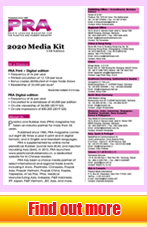Packaging: Primary packaging through the pandemic

By Eric Roegner President, Amcor Rigid Packaging
Amcor’s polyethylene terephthalate (PET) bottles and jars serve an important purpose by protecting the products that keep us nourished, healthy, hydrated, and clean. During the Covid-19 pandemic, there have been clear shifts in shopping practices, product demand, and channel distribution. Despite these changing consumer patterns, the role of packaging has never been more vital, enabling the safe delivery of food, beverages, healthcare products, and home and personal care items including cleaning supplies, hand sanitiser and other essentials.
These are extraordinary times which bring insights and opportunities.
Disruption demands different
While PET packaging has continued to deliver on its lightweight, safety, and sustainability benefits, the Covid-19 outbreak has caused a shift in the products that consumers demand. During the first quarter, Multi-Channel Merchant reported that demand for hand sanitiser skyrocketed more than 800%. This demand created an opportunity for hundreds of US distilleries and wineries to rapidly transform their operations to produce and package hand sanitiser under guidance from the Food and Drug Administration.
Amcor jumped in to assist current customers from the spirits, home, and personal care segments with their bottling needs and supported smaller distilleries as they activated locally. Shifting from wine or spirits to hand sanitiser requires adjustments to the entire operation including a necessary shift in the packaging format, typically from glass to PET bottles.
Producing and packaging hand sanitiser locally is manual and requires all hands on deck. Glass bottles can break, are heavy, often more expensive to transport, and not easy to recycle. PET, however, won’t shatter – so no breaking bottle will shut the line down to remove glass contamination or to prevent an injury. In addition, according to Amcor’s Asset Lifecycle Analysis, PET bottles often have a lower carbon footprint than alterative glass bottles.
For example, Michigan-based Ugly Dog Distillery, one of the oldest craft distilleries in the US, shifted its production facilities from spirits to hand sanitiser – and they are giving it away to people and organisations that need it the most.
A McKinsey & Co. report finds consumers’ shopping behaviour has changed because of the crisis. Trips to the grocery store are less frequent and “on-the-go” convenience store traffic has declined. However, ecommerce growth, which was slow to see traction in grocery, has more than doubled during the pandemic. The report notes that sales in this channel will see a sustained post-crisis increase. As a result, the bottles and jars produced for the ecommerce supply chain must function accordingly – no leaks, breaks, or dents. Since consumers will not tolerate a poor unboxing experience, an opportunity for PET packaging has opened. PET bottles and jars stand up to the rigors of the ecommerce channel, providing benefits such as lighter weight, reduced carbon footprint, reduced freight costs, breakage and safety advantages, and easy handling and opening.
Shelter-in and socially connect
On March 13, I gave a speech at a packaging industry trade show in Chicago. I haven’t travelled since. With travel restrictions eliminating face-to-face engagement, we’ve changed how we interact with our work teams and customers by incorporating more video conferencing. This technology has become the backbone of the work-from-home strategy which many businesses have enacted, as without warning our home and work lives have collided. Now, I spend most of my time in virtual meetings – sometimes those meetings include family member cameos.
According to Computer World magazine, the demand for video conferencing apps has surged in recent weeks, with enterprise-focused mobile app downloads reaching 62 million during the week 14-21 March, the highest number ever seen. That figure was up 45% from the week before and up 90% from the pre-Covid-19 weekly download average. Business application downloads represent the highest growth in any category in both the iOS and Google Play stores.
Today, we update profiles, share content, and incorporate the right key words and hashtags so people can find us quickly. Working through the pandemic stay-at-home orders, social media channels have enabled the supply chain to remain “open for business.” Our sales team found opportunities through social media friends and community organisation timelines. LinkedIn was where customers offered us virtual “pats on the back” for on-time deliveries and maintaining production schedules and commitments, often to their own local communities.
Read more...
(PRA) Subscribe to Get the Latest Updates from PRA Please click here
©2020 Plastics and Rubber Asia. All rights reserved.

©2020 Plastics and Rubber Asia. All rights reserved.
Home Terms & Conditions Privacy Policy Webmail Site Map About Us





















